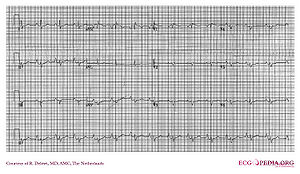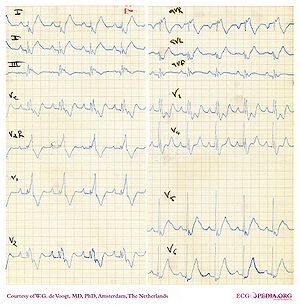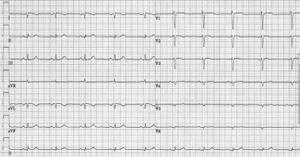ECG in Congenital Heart Disease: Difference between revisions
Jump to navigation
Jump to search
Secretariat (talk | contribs) |
Secretariat (talk | contribs) |
||
| Line 11: | Line 11: | ||
==Ventricular Septal Defect== | ==Ventricular Septal Defect== | ||
Information about [[w:Ventricular_septal_defect|Ventricular Septal Defect on Wikipedia (external link)]] | |||
*[[Rhythm]]: normal sinus rhythm, PVCs | *[[Rhythm]]: normal sinus rhythm, PVCs | ||
*[[Conduction|PR interval]]: Normal or mild ↑; 1° AVB 10% | *[[Conduction|PR interval]]: Normal or mild ↑; 1° AVB 10% | ||
Revision as of 16:05, 22 December 2010
Congenital Heart Disease can result in ECG changes, often related to atrial or ventricular overload and enlargement. Below a list of relatively common forms of congenital heart disease and their potential ECG changes. Adapted from Khairy et al.[1]
Secundum atrial septal defect
Information about Secundum atrial septal defec on Wikipedia (external link)
- Rhythm: normal sinus rhythm, increased risk of AF with age
- PR interval: first degree AV block in 6-19%
- QRS axis: 0° to 180°; RAD; LAD in Holt-Oram or LAHB
- QRS Configuration: rSr´ or rsR´ with RBBBi>RBBBc
- Atrial Enlargement: RAE 35%
- Ventricular hypertrophy: Uncommon
- Particularities: "Crochetage" pattern
Ventricular Septal Defect
Information about Ventricular Septal Defect on Wikipedia (external link)
- Rhythm: normal sinus rhythm, PVCs
- PR interval: Normal or mild ↑; 1° AVB 10%
- QRS axis: RAD with BVH; LAD 3% to 15%
- QRS Configuration: Normal or rsr´; possible RBBB
- Atrial Enlargement: Possible RAE±LAE
- Ventricular hypertrophy: BVH 23% to 61%; RVH with Eisenmenger
- Particularities: Katz-Wachtel phenomenon
AV canal defect
- Rhythm: normal sinus rhythm, PVCs 30%
- PR interval: 1° AVB >50%
- QRS axis: Moderate to extreme LAD; normal with atypical
- QRS Configuration: rSr´ or rsR´
- Atrial Enlargement: Possible LAE
- Ventricular hypertrophy: Uncommon in partial; BVH in complete; RVH with Eisenmenger
- Particularities: Inferoposteriorly displaced AVN
Patent ductus arteriosus
- Rhythm: normal sinus rhythm, ↑ IART/AF with age
- PR interval: ↑ PR 10% to 20%
- QRS axis: Normal
- QRS Configuration: Deep S V1, tall R V5 and V6
- Atrial Enlargement: LAE with moderate PDA
- Ventricular hypertrophy: Uncommon
- Particularities: Often either clinically silent or Eisenmenger
Pulmonary stenosis
- Rhythm: normal sinus rhythm
- PR interval: Normal
- QRS axis: Normal if mild; RAD with moderate/severe
- QRS Configuration: Normal; or rSr´; R´ increases with severity
- Atrial Enlargement: Possible RAE
- Ventricular hypertrophy: RVH; severity correlates with R:S in V1 and V6
- Particularities: Axis deviation correlates with RVP
Aortic coarctation
- Rhythm: normal sinus rhythm
- PR interval: Normal
- QRS axis: Normal or LAD
- QRS Configuration: Normal
- Atrial Enlargement: Possible LAE
- Ventricular hypertrophy: LVH, especially by voltage criteria
- Particularities: Persistent RVH rare beyond infancy
Ebstein’s anomaly
Information about Ebstein's anomaly on Wikipedia (external link)
- Rhythm: normal sinus rhythm, possible EAR, SVT; AF/IART 40%
- PR interval: 1° AVB common; short if WPW
- QRS axis: Normal or LAD
- QRS Configuration: Low-amplitude multiphasic atypical RBBB
- Atrial Enlargement: RAE with Himalayan P waves
- Ventricular hypertrophy: Diminutive RV
- Particularities: Accessory pathway common; Q II, III, aVF, and V1–V4
Surgically repaired TOF
- Rhythm: normal sinus rhythm, PVCs; IART 10%; VT 12%
- PR interval: Normal or mild ↑
- QRS axis: Normal or RAD; LAD 5% to 10%
- QRS Configuration: RBBB 90%
- Atrial Enlargement: Peaked P waves; RAE possible
- Ventricular hypertrophy: RVH possible if RVOT obstruction or PHT
- Particularities: QRS duration±QTd predictive of VT/SCD
Congenitally corrected TGA
- Rhythm: normal sinus rhythm
- PR interval: 1° AVB >50%; AVB 2%/year
- QRS axis: LAD
- QRS Configuration: Absence septal q; Q in III, aVF, and right precordium
- Atrial Enlargement: Not if no associated defects
- Ventricular hypertrophy: Not if no associated defects
- Particularities: Anterior AVN; positive T precordial; WPW with Ebstein’s
Complete TGA/intra-atrial baffle
- Rhythm: Sinus brady 60%; EAR; junctional; IART 25%
- PR interval: Normal
- QRS axis: RAD
- QRS Configuration: Absence of q, small r, deep S in left precordium
- Atrial Enlargement: Possible RAE
- Ventricular hypertrophy: RVH; diminutive LV
- Particularities: Possible AVB if VSD or TV surgery
UVH with Fontan
- Rhythm: Sinus brady 15%; EAR; junctional; IART >50%
- PR interval: Normal in TA; 1° AVB in DILV
- QRS axis: LAD in single RV, TA, single LV with noninverted outlet
- QRS Configuration: Variable; ↑R and S amplitudes in limb and precordial leads
- Atrial Enlargement: RAE in TA
- Ventricular hypertrophy: RVH with single RV; possible LVH with single LV
- Particularities: Absent sinus node in LAI; AV block with L-loop or AVCD
Dextrocardia
- Rhythm: normal sinus rhythm, P-wave axis 105° to 165° with situs inversus
- PR interval: Normal
- QRS axis: RAD
- QRS Configuration: Inverse depolarization and repolarization
- Atrial Enlargement: Not with situs inversus
- Ventricular hypertrophy: LVH: tall R V1–V2; RVH: deep Q, small R V1 and tall R right lateral
- Particularities: Situs solitus: normal P-wave axis and severe CHD
ALCAPA
- Rhythm: normal sinus rhythm
- PR interval: Normal
- QRS axis: Possible LAD
- QRS Configuration: Ant-lat Q waves; possible ant-sept Q waves
- Atrial Enlargement: Possible LAE
- Ventricular hypertrophy: Selective hypertrophy of posterobasal LV
- Particularities: Possible ischemia


